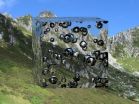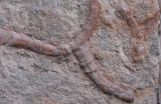(Press-News.org) WASHINGTON, D.C., December 18, 2014 -- Uncork a bottle of champagne, and as the pressure of the liquid is abruptly removed, bubbles immediately form and then rapidly begin the process of "coarsening," in which larger bubbles grow at the expense of smaller ones.
This fundamental nonequilibrium phenomenon is known as "Ostwald ripening," and though it is most familiar for its role in bubbly beverages, it is also seen in a wide range of scientific systems including spin systems, foams and metallic alloys.
On a much larger scale, Ostwald ripening can be observed in a power-generating turbine. Most power stations rely on boilers to convert water into steam, but the phase transition involved is highly complex. During the phase transition, no one is exactly sure what's occurring inside the boiler -- especially how bubbles form.
So a team of researchers from the University of Tokyo, Kyusyu University and RIKEN in Japan set out to find an answer. In the Journal of Chemical Physics, from AIP Publishing, the researchers describe how they were able to simulate bubble nucleation from the molecular level by harnessing the K computer at RIKEN, the most powerful system in Japan.
At the heart of their work were molecular dynamics simulations. The basic concept behind these simulations is to put some virtual molecules in a box, assign them initial velocities and study how they continue moving -- by using Newton's law of motion to determine their position over time. There were major challenges in doing this, explained Hiroshi Watanabe, a research associate at the University of Tokyo's Institute for Solid State Physics.
"A huge number of molecules, however, are necessary to simulate bubbles -- on the order of 10,000 are required to express a bubble," Watanabe said. "So we needed at least this many to investigate hundreds of millions of molecules -- a feat not possible on a single computer."
The team, in fact, wound up simulating a whopping 700 million particles, following their collective motions through a million time steps -- a feat they accomplished by performing massively parallel simulations using 4,000 processors on the K computer. This was, to the best of their knowledge, the first simulation to investigate multi-bubble nuclei without relying on any artificial conditions.
"In the past, while many researchers wanted to explore bubble nuclei from the molecular level, it was difficult due to a lack of computational power," explained Watanabe. "But now, several petascale computers -- systems capable of reaching performance in excess of one quadrillion point operations per second -- are available around the world, which enable huge simulations."
The team's key finding? The time evolutions of bubbles are well described by a classical theory developed during the 1960s, a mathematical framework called "LSW theory" after its three developers -- Lifshift and Slyozov in Soviet Union and Wagner in Germany. While LSW theory has been shown to hold true for other systems, like ice crystals growing in so-called freezer-burned ice cream, prior to this work nobody had ever shown it also works for describing gas bubbles in liquid.
"While the nucleation rate of droplets in condensation is well predicted by the classical theory, the nucleation rates of bubbles in a superheated liquid predicted by the theory are markedly different from the values observed in experiments," Watanabe said. "So we were expecting the classical theory to fail to describe the bubble systems, but were surprised to find that it held up."
In other words, although Watanabe and colleagues had hoped their simulation would provide clues to help clarify why the classical theory fails to predict the rate of bubble nucleation, it remains a mystery.
As far as implications of the team's work, an enhanced understanding of the behavior of bubbles is very important for the field of engineering because it may enable the design of more efficient power stations or propellers.
What's next for the researchers? After exploring cavitation, they're now shifting their focus to boiling. "Bubbles appear when liquid is heated as 'boiling,' or as 'cavitation' when the pressure of the liquid decreases," said Watanabe. "Simulating boiling is more difficult than cavitation at the molecular level, but it will provide us with new knowledge that can be directly applied to designing more efficient dynamo."
The team is also targeting a polymer solution. "Surfactants make bubbles stable, while defoamers make them unstable," he added. "Recent developments in computational power will allow us to simulate these kinds of complex systems at the molecular level."
INFORMATION:
The article, "Ostwald ripening in multiple-bubble nuclei," is authored by Hiroshi Watanabe, Masaru Suzuki, Hajime Inaoka and Nobuyasu Ito. It will appear in the Journal of Chemical Physics on December 18, 2014 (DOI: 10.1063/1.4903811). After that date, it can be accessed at: http://scitation.aip.org/content/aip/journal/jcp/141/23/10.1063/1.4903811
The authors of this paper are affiliated with the University of Tokyo, Kyusyu University and the Japan Advanced Institute for Computational Science.
ABOUT THE JOURNAL
The Journal of Chemical Physics publishes concise and definitive reports of significant research in the methods and applications of chemical physics. See: http://jcp.aip.org
Cilia, the cell's tails and antennas, are among the most important biological structures. They line our windpipe and sweep away all the junk we inhale; they help us see, smell and reproduce. When a mutation disrupts the function or structure of cilia, the effects on the human body are devastating and sometimes lethal.
The challenge in diagnosing, studying and treating these genetic disorders, called ciliopathies, is the small size of cilia -- about 500-times thinner than a piece of paper. It's been difficult to examine them in molecular detail until now.
Professor ...
COLUMBIA, Mo. - A new study from University of Missouri and Virginia Tech researchers is challenging accepted ideas about how ancient soft-bodied organisms become part of the fossil record. Findings suggest that bacteria involved in the decay of those organisms play an active role in how fossils are formed--often in a matter of just a few tens to hundreds of years. Understanding the relationship between decay and fossilization will inform future study and help researchers interpret fossils in a new way.
"The vast majority of the fossil record is composed of bones and ...
New Rochelle, NY, December 18, 2014--Internet addiction is an impulse-control problem marked by an inability to inhibit Internet use, which can adversely affect a person's life, including their health and interpersonal relationships. The prevalence of Internet addiction varies among regions around the world, as shown by data from more than 89,000 individuals in 31 countries analyzed for a study published in Cyberpsychology, Behavior, and Social Networking, a peer-reviewed journal from Mary Ann Liebert, Inc., publishers. The article is available free on the Cyberpsychology, ...
Health care systems and providers are not attuned to older adults' malnutrition risk, and ignoring malnutrition exacts a toll on hospitals, patients, and payers, according to the latest issue of the What's Hot newsletter from The Gerontological Society of America (GSA).
Under the title "Aging Policy: Preventing and Treating Malnutrition to Improve Health and Reduce Costs," the new installment points out that aging is a risk factor for malnutrition and highlights opportunities to improve nutrition awareness, interventions, and policy priorities.
Support for the publication ...
To paraphrase Mark Twain, the report of the Kepler spacecraft's death was greatly exaggerated. Despite a malfunction that ended its primary mission in May 2013, Kepler is still alive and working. The evidence comes from the discovery of a new super-Earth using data collected during Kepler's "second life."
"Like a phoenix rising from the ashes, Kepler has been reborn and is continuing to make discoveries. Even better, the planet it found is ripe for follow-up studies," says lead author Andrew Vanderburg of the Harvard-Smithsonian Center for Astrophysics (CfA).
NASA's ...
New Rochelle, NY, December 18, 2014--Pretreatment of cellulosic biomass using cell wall degrading enzymes is a critical step in the release of sugars needed to produce biofuels and renewable, biobased chemicals and materials. A new study that demonstrates and quantifies the impact of enzymatic hydrolysis and drying on the nanostructure and available reaction volume of pretreated hardwoods and switchgrass is published in Industrial Biotechnology, a peer-reviewed journal from Mary Ann Liebert, Inc., publishers. The article is available on the Industrial Biotechnology website ...
PHILADELPHIA - Type 1 diabetes (T1D) patients who have developed low blood sugar (hypoglycemia) as a complication of insulin treatments over time are able to regain normal internal recognition of the condition after receiving pancreatic islet cell transplantation, according to a new study led by researchers at the Perelman School of Medicine at the University of Pennsylvania, published online in Diabetes. Severe hypoglycemia--a life-threatening complication of insulin treatment for T1D--can occur when the body's defense mechanisms against low blood sugar are broken down ...
Detroit- A Wayne State University interdisciplinary research team in the Eugene Applebaum College of Pharmacy and Health Sciences has made a surprising discovery: older, more mature motorists -- who typically are better drivers in many circumstances -- are much worse than their younger counterparts when texting while driving. Currently published online and scheduled to be published in print in the January 2015 issue of Accident Analysis and Prevention, the study "The Effects of Texting on Driving Performance in a Driving Simulator: The Influence of Driver Age" explores ...
Many of the worst West Coast winter floods pack a double punch. Heavy rains and melting snow wash down the mountains together to breach riverbanks, wash out roads and flood buildings.
These events are unpredictable and difficult to forecast. Yet they will become more common as the planet warms and more winter precipitation falls as rain rather than snow.
University of Washington mountain hydrology experts are using the physics behind these events to better predict the risks.
"One of the main misconceptions is that either the rain falls and washes the snow away, or that ...
HEIDELBERG, 18 December 2014 - The quality of the colon mucus in mice depends on the composition of gut microbiota, reports a Swedish-Norwegian team of researchers from the University of Gothenburg and the Norwegian University of Life Sciences in Oslo. The work, published in EMBO reports, suggests that bacteria in the gut affect mucus barrier properties in ways that can have implications for health and disease.
"Genetically similar mice with subtle but stable and transmissible intestinal microbiota showed unexpectedly large differences in the inner colon mucus layer. ...






